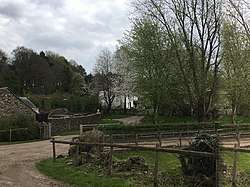Great House, Llanarth
| Great House, Llanarth | |
|---|---|
 "an impressively intact late 16th/17th century farmhouse " | |
| Type | Farmhouse |
| Location | Llanarth, Monmouthshire |
| Coordinates | 51°46′04″N 2°55′34″W / 51.7679°N 2.9261°WCoordinates: 51°46′04″N 2°55′34″W / 51.7679°N 2.9261°W |
| Built | late-16th century |
| Architectural style(s) | Vernacular |
| Governing body | Privately owned |
Listed Building – Grade II* | |
| Official name: Great House | |
| Designated | 15 March 2000 |
| Reference no. | 22999 |
Listed Building – Grade II | |
| Official name: Barn range at Great House, Clytha | |
| Designated | 15 March 2000 |
| Reference no. | 23000 |
 Location of Great House, Llanarth in Monmouthshire | |
Great House, Llanarth, Monmouthshire is a farmhouse dating from the late-16th century. Extended in the mid-17th century and little altered thereafter, it is a Grade II* listed building. The detached barn range has its own Grade II listing.
History
The architectural historian John Newman dates the original house to the late 16th century.[1] Sir Cyril Fox and Lord Raglan, in their three-volume study, Monmouthshire Houses, note that the original house, of a two-room plan which Cadw dates to 1580,[2] was extended c.1620 to create a parlour.[3] The house was again extended and modernised "before (Fox and Raglan's inspection in) 1942".[3] In a tithe map of 1845, the house, together with 127 acres, is recorded as part of Sir Samuel Fludyer's Trostrey Court estate and was being farmed by a William Griffiths.[2] Now part of the Pontypool Park Estate, the farm remains privately-owned.[2]
Architecture and description
Constructed of white washed rubble, and of two storeys with attics, the house has a substantial stair-turret to its western end.[2] Fox and Raglan note that the staircase wing had, until the Second World War, "a complete set of door frames which added to the dignity of the house".[3] The house has a Grade II* listing, Cadw's record describing it as "an impressively intact farmhouse".[2] The barn and stable block facing Great House, date from the 18th and 19th centuries respectively, and has its own Grade II listing.[4]
Notes
- ↑ Newman 2000, p. 192.
- 1 2 3 4 5 "Listed Buildings - Full Report - HeritageBill Cadw Assets - Reports". cadwpublic-api.azurewebsites.net.
- 1 2 3 Fox & Raglan 1994, p. 31.
- ↑ "Listed Buildings - Full Report - HeritageBill Cadw Assets - Reports". cadwpublic-api.azurewebsites.net.
Sources
- Fox, Cyril; Raglan, Lord (1994). Renaissance Houses, Part 3. Monmouthshire Houses. Cardiff: Merton Priory Press Ltd & The National Museum of Wales. ISBN 1-898937-00-1.
- Newman, John (2000). Gwent/Monmouthshire. The Buildings of Wales. London: Penguin. ISBN 0-14-071053-1.